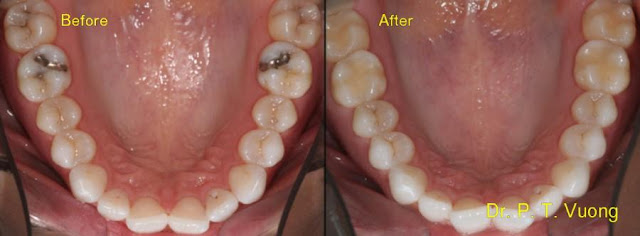What is a cavity? What does it look like? Is it supposed to hurt? What happens when your tooth has big hole in it?
Although this young person hasn't been to the dentist in 5-7 years, overall she has good teeth, healthy gums, and no pain at all. However, can you point out to me which teeth have cavities? Do you think these need to be treated as soon as possible? How deep do you think they are? Do you think there are cavities in between teeth as well? What would happen if this patient delays treatment?
Do all cavities have holes in them? It's okay for you to guess. Dentists are not guessing which of your teeth has a cavity or caries when they tell you that you have a cavity. It takes many years of reading X-rays, looking for signs of a cavity, and past experiences to diagnose them properly. When diagnosed, treatment should be done as soon as possible to receive the best prognosis and saving more of your tooth! You will be glad you did!
Cavities, sometimes called tooth decay, or caries, develop from breakdown of your enamel and soon the softer dentin layer of your teeth. Most of us blame cavities on eating too much sugars and candies, but it's only half true. Bacteria, normally present in your mouth environment, are the ones that feed on sugars and carbohydrates, and make acid as their waste product. The acid not only irritates your gums, causes gum bleeding, it also breaks down your teeth. Not all cavities have "holes" in them. You may have a cavity or decay under your existing fillings, or crowns. White fillings can turn black from recurrent decay or failure in bonding as they get older and stressed from daily use. Some older fillings break because they have decay underneath. When you can actually see a hole in your tooth, the decay is too big and you need to have that treated as soon as you can to prevent more damage. When your cavities are too big, you may not be able to do a filling anymore, you may need a root canal (when the cavity is too close to the nerve), a large buildup, and/or a crown.
So could you point out which teeth have cavities here? We just finished the treatment for this patient. We will have taken out the wisdom teeth that had cavities in them. See the new photos.
Close up view of the finished new white fillings.
Here's a picture of a very deep cavity in a molar. It doesn't really have a hole in it for you to feel that it is there. Though this patient is not aware of it because it is not sensitive or hurting yet, it is very advanced and even involves the contact areas between teeth that can be detected on X-rays called the Bitewing X-rays. Treating a cavity as soon as possible can prevent the need for root canal as the deeper cavity reaches close to the nerve inside. Flossing will prevent future problems in the restorations or fillings and ensure they will last much longer.
Here I was using a different camera, and I have increased the contrast setting in these images to show the failed white filling that had significant amount of decay or softness underneath once the existing filling was removed. You can also see the crack line in the third image. The dark dentin was good tooth structure so that was not removed. We masked the darkness and filled the rest of the cavity, checked the bite, and made sure that all the margin was sealed tight. Failing filling or restoration treated early, more often than not, can prevent the need for root canal, which many people dread. Though this cavity was significantly much deeper, the patient reported no sensitivity. He was quite pleased to see that they all blended in nicely without the dark lines. No root canal!
This series of pictures shows what appeared to be a small cavity turned out to be very deep! These types of cavities are often missed during the exam when the grooves are not cleaned out, or the criteria used by one dentist are different from another. Some dentists may not consider this a cavity that needs treatment yet. To make matters more complicated, when a dentist diagnoses a cavity, patients may hesitate to get the treatment right away, and over time have forgotten that they ever have a cavity.
As you can see, when these grooves are opened, the cavity looks very bad. By first opening the grooves, and using a slow speed handpiece and round bur (a safer way to remove the softer decay tooth than a high speed drill), Dr. Vuong cleaned out and checked for any remaining decay. Once cleaned out, a new filling can be done and verified that all the margins are sealed properly. When the bite is checked and proper steps are observed, this patient should experience little or any post-operative sensitivity at all.
As shown in the examples above, the sooner the cavities are treated, the better it is, and you may avoid pain, sensitivity, or even root canal treatment.







